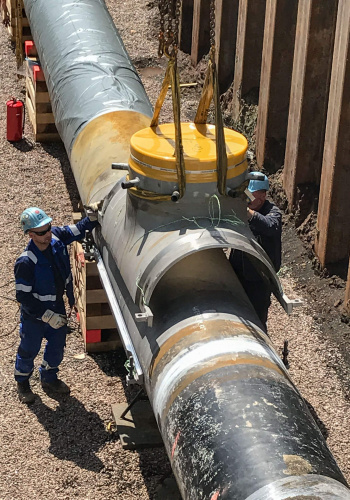Drilling and stoppling of high-pressure gas pipelines
For more than 20 years, RMT has gained valuable experience in the extremely efficient technique of drilling and plugging (stoppling). Over the last two decades, we have been successfully completed several hundred operations with this special technology using our own equipment and an experienced team. RMT is thus able to clearly differentiate itself from competitors thanks to this special service.
RMT: the perfect partner
Drilling and stoppling measures on high-pressure gas pipelines can be implemented with nominal diameters up to DN1200 (48”) and operating pressures up to 100 bar.
RMT offers an all-inclusive service and project-specific solutions from a single supplier for this specialisation:
- Engineering and planning
- Construction supervision and implementation with own employees and equipment
- Provision of emergency supplies (bypass pipelines)
- Insulation and coating work
- Civil and underground engineering for turnkey projects
- Pressure tests up to 200 bar


Strict requirements, great advantages
Working under constant “embedment conditions” imposes strict requirements on personnel and technology. However, the advantages are clear to see: This technology ensures reliable supplies during active pipeline operation while high-pressure gas pipelines are being repaired and embedded. What’s more, methane emissions and energy losses are minimised and the environment is protected.
RMT thus makes a crucial contribution to uninterrupted energy supply from a financial and ecological standpoint.
Drilling
The simplest, most cost-effective method to install pipeline outlets, branches and connections is the stopple procedure, which does not interrupt gas supply. Nozzles or split T-pieces are positioned and welded on the base pipe and undergo non-destructive testing. The pipe is then drilled under pressure with a drilling device and using a suitable shut-off valve.
The drilled pipe section is anchored to the drill head by a special device and detached from the pipeline when the drill is removed. Once the pipe has been drilled through, the drill is removed and the shut-off valve closed. The drilling device is depressurised and can then be disassembled.
Stoppling
The Stopple method ensures supply can be maintained via a bypass pipe during repair or integration work on pipelines. Two drill holes are sufficient, which reduces the work and time required and saves on costs. This method is often used to maintain gas supply while pipe layouts need to be changed or sections need to be replaced.
Work includes planning, procurement and coordination of work, pressure and leakage tests and welding Stopple T-pieces and TOR fittings with induction preheating while pipes are in operation.
Pipe line protection – sleeve joint welding
Fitting and welding split sleeve joints can be used to secure corrosion defects, cracks, component defects, weld seam defects and similar. This work is also performed when there is a medium flow and the pipeline is
under pressure and thus has no impact on the required energy supply. somit keinen Einfluss auf die notwendige Energieversorgung. Methan-Emissionen und Energieverluste werden hierbei vollständig vermieden.


